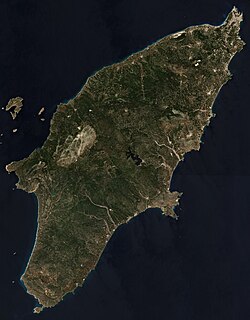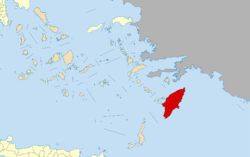
Back Rhodos Afrikaans Rhodos ALS ሩድ Amharic Rodas AN Roðos ANG رودس Arabic رودس ARZ Rodes AST Rodos Azerbaijani Родас Byelorussian
Rhodes
Ρόδος | |
|---|---|
Island and municipality | |
 | |
| Nickname: Island of the Sun | |
 Location in the South Aegean administrative region of Greece | |
| Coordinates: 36°10′N 27°55′E / 36.17°N 27.92°E | |
| Country | |
| Administrative region | South Aegean |
| Prefecture | Dodecanese |
| Regional unit | Rhodes |
| Seat | Rhodes |
| Government | |
| • Mayor | Alexandros Koliadis |
| Area | |
• Total | 1,400.68 km2 (540.81 sq mi) |
| Highest elevation | 1,216 m (3,990 ft) |
| Lowest elevation | 0 m (0 ft) |
| Population (2021) | |
• Total | 125,113 |
| • Density | 89/km2 (230/sq mi) |
| Demonym(s) | Rhodian, Rhodiot or Rhodiote (rare) |
| Time zone | UTC+2 (EET) |
| • Summer (DST) | UTC+3 (EEST) |
| Postal codes | 851 00, 851 31, 851 32, 851 33 (for Rhodes town) |
| Telephone | 2241, 2244, 2246 |
| Website | www |

Rhodes (/roʊdz/ ; Greek: Ρόδος, romanized: Ródos [ˈroðos]) is the largest of the Dodecanese islands of Greece and is their historical capital; it is the ninth largest island in the Mediterranean Sea. Administratively, the island forms a separate municipality within the Rhodes regional unit, which is part of the South Aegean administrative region. The principal town of the island and seat of the municipality is the city of Rhodes,[1] which had 50,636 inhabitants in 2011. In 2022, the island had a population of 125,113 people.[2] It is located northeast of Crete and southeast of Athens. Rhodes has several nicknames, such as "Island of the Sun" due to its patron sun god Helios, "The Pearl Island", and "The Island of the Knights", named after the Knights of Saint John of Jerusalem, who ruled the island from 1310 to 1522.[3]
Historically, Rhodes was famous for the Colossus of Rhodes, one of the Seven Wonders of the Ancient World. The Medieval Old Town of the City of Rhodes has been declared a World Heritage Site. Today, it is one of the most popular tourist destinations in Europe.[4][5][6][7]
- ^ "ΦΕΚ A 87/2010, Kallikratis reform law text". Government Gazette (in Greek). Archived from the original on 6 September 2021. Retrieved 7 September 2021.
- ^ "census 2022" (PDF).
- ^ "Rhodes". Visit Greece. Archived from the original on 29 December 2014. Retrieved 29 December 2014.
- ^ Paul Hellander, Greece, 2008
- ^ Duncan Garwood, Mediterranean Europe, 2009
- ^ Ryan Ver Berkmoes, Oliver Berry, Geert Cole, David Else, Western Europe, 2009
- ^ Harry Coccossis, Alexandra Mexa, The challenge of tourism carrying capacity assessment: theory and practice, 2004

